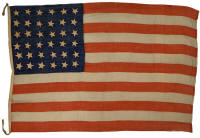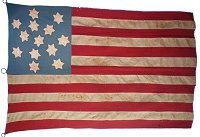|
|
Canton.
The canton of an
American Flag is the
blue background and
stars in the upper
left quadrant of the
flag. It
consists of the
"field" and the
"stars".
Usage:
"The canton
of this rare 38 star
flag advertising
card features a
beautiful portrait
of George
Washington." |
 |
|
|
Field. The
field is the background upon
which the stars are
set. The field on
American flags is
typically blue, but
can vary and shade
from very pale gray
to deep blue to near
black.
Usage:
"The field
of this 36 star flag
is a beautiful
cornflower blue." |
 |
|
|
Hoist. The
hoist is the part of the flag
along the left side that contains the
hardware used for
raising the flag,
and which is fixed
to a pole or staff
when the flag is in
use. The term
is also used to
describe the
vertical height of
the flag.
Usage:
"The hoist
of this 36 star flag
is a sleeve, through
which a braided hemp
rope is passed."
Usage: "The
flag is 54 inches on
the hoist." |
 |
|
|
Fly. The
fly end of the flag
is the end that is
allowed to wave
freely when the flag
is raised. It
is also a term used
to describe the
horizontal length of
the flag.
Usage:
"The fly
end of this 34 star
flag is turned back
and hand sewn."
Usage:
"This flag is 105
inches on the fly." |
 |
|
|
Stars. The
stars are a
geometric multipoint
figure usually
having symmetrically
projecting points.
They are often
symbolic of
celestial stars.
Five pointed stars
are typical on
American flags,
though rare flags
with stars of four,
six, seven, eight or
more points are
known.
Usage:
"The stars
of this rare 13 star
flag of the Civil
War era are
six-pointed." |
 |
|
|
Stripes.
The stripes are the horizontal or
vertical red and
white alternating
pattern to the side
of and below the
canton.
Usage:
"The sixteen
stripes of this
American Civil Flag
run vertically and
represent the
sixteen states in
the union at the
time when the flag's
design became
official in 1799." |
 |
|
|
Center Point.
The
center point of the
flag is the point where the lower
right portion of the
canton meets the
stripes.
Usage:
"The center
point of this
25 star flag shows the rare
trait of the canton
having been inserted
into the red
stripe." |
 |
|
|
Grommet.
A grommet is a reinforced hole in
the hoist of a flag
through which a rope
can be passed or to
which ropes can be
tied in order to
raise the flag.
Specific types of
grommets include
"metal grommets",
and "whip stitched
grommets".
Usage:
"The whip
stitched grommets
of this 35 star flag
are hand sewn." |
 |
|
|
Ring. A
metal ring sewn into
and extending from
the hoist, through
which a rope is
passed or to which a
rope is tied in
order to raise the
flag.
Usage:
"A ring is
sewn to the hoist of
this hand sewn 45
star flag as another
means for securing
the flag to a flag
pole.
|
 |
|
|
Sleeve. A
sleeve is a specific
type of hoist such
that a pole can be
inserted along the
length of the hoist.
Usage:
"A
soldier would have
inserted a wooden
staff into the blue
sleeve on
this 34 star Company
Battle Flag of
Company L, 102nd
Pennsylvania
Volunteers when it
was carried during
the Civil War."
|
 |
|
|
Cord and Tassels.
A cord is a braided rope with
a
decorative fringed
knob, known as a
tassel. The
tassel is often made of
fabric-covered wood.
The cord and tassels
hang down
from the top left
corner of the hoist.
Usage:
"This red,
white and blue
cord with beautiful
tassels belong
to the 34 star
Battle Flag of
Company L, 102nd
Pennsylvania
Volunteers." |

|
|
|
Fringe.
Fringe consists of braided strands sewn
around the edges of
a flag added for
decorative effect.
Usage:
"The
alternating red,
white and blue
fringe along the
borders of this 38
star flag have a
beautiful decorative
effect." |
 |
|
|
Selvedge.
The selvedge is the
reinforced border or
edge of the fabric,
created as it is
produced on a loom,
which keeps the
fabric from
unraveling or
fraying.
Experienced flag
makers use the
selvedge on the
outward edges of the
top and bottom
stripes to
strengthen the edges
and prevent
fraying.
Consequently, the
presence of selvedge
on the top and
bottom stripes is a
good indication
that a flag was made
by someone
experienced.
Usage:
"The selvedge
of the fabric of
this early 27 star
flag can be seen
along the edge of
the top stripe."
|
 |
|
|
Gusset.
Gussets are
additional pieces of
fabric added to the
stress points of the
flag, usually in the
corners where the
canton meets the
hoist, that
reinforces the flag
to prevent tearing.
Usage:
"The
gusset
reinforces the
bottom red stripe at
the point where it
is sewn to the
hoist." |
 |
|
|
Stenciling.
The practice of
using stenciled
templates to paint
or mark text onto
the flag, usually on
the hoist.
Stencils most
typically show the
manufacturer of the
flag, the size of
the flag, or, in
rare cases, patent
information.
Usage:
"The
stenciling on
the hoist of the
flag indicates that
the flag was made by
W. M. Horstmann
Company,
Philadelphia,
Pennsylvania."
|
 |
|
|
Maker's Label
or
Maker's Tag.
A printed tag sewn
or glued to the
hoist of a flag that
provides information
about the
manufacturer and
often about the
characteristics of
the materials and
coloration of the
flag. A
characteristic
predominantly from the 20th century
onward,
their style and text
can be useful for
attributing and dating 20th century
flags.
Usage:
"The
maker's tag
on this yacht ensign
indicates that the flag
is constructed of
double-warp all wool
bunting."
|
 |

